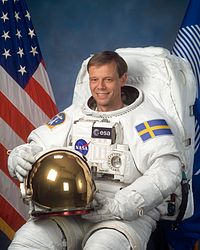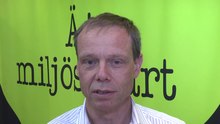Christer Fuglesang
| Christer Fuglesang | |
|---|---|

|
|
| Country: | Sweden |
| Organization: | ESA |
| selected on | May 15, 1992 |
| Calls: | 2 space flights |
| Start of the first space flight: |
December 10, 2006 |
| Landing of the last space flight: |
September 12, 2009 |
| Time in space: | 26d 17h 38min |
| EVA inserts: | 5 |
| EVA total duration: | 31h 54min |
| Space flights | |
Arne Christer Fuglesang ( pronunciation : [ ˌkɹisːtəɹ ˈfʉːgləsaŋ ], born March 18, 1957 in Stockholm ) is a Swedish physicist and astronaut . He was the first Scandinavian and the only Swede in space until Jessica Meir's flight in September 2019.
Life
Fuglesang grew up as the son of a Swede and a Norwegian in Stockholm. After primary school, he attended Bromma-Gymnasium and passed his Abitur in 1975. He then studied technical physics at the Royal Technical University KTH (Kungliga Tekniska Högskolan), which awarded him a master's degree in 1981 . At the University of Stockholm (Stockholms Universitet) he specialized in particle physics and a doctorate in experimental particle physics in 1987.
Already as a prospective graduate student, Fuglesang was the research center CERN in Switzerland, Geneva worked. After receiving his doctorate in 1988, he was given a permanent position as a project manager. In his first year he did research at the K meson and then became the head of particle recognition. From November 1990 he worked at the Manne Siegbahn Institute in Stockholm.
Christer Fuglesang is married and has three children. His hobbies include sailing, skiing, playing Frisbee and reading.
Astronaut activity
When the European Space Agency (ESA) began looking for applicants for its second group of astronauts in 1989, Fuglesang and another 22,000 Europeans got in touch. Each ESA member country was asked to propose between three and five candidates. A total of 60 potential applicants from all European ESA countries came together on May 8, 1991, and on May 15, 1992 six of them were presented to the public as new members of the European astronaut corps .
Euromir
Together with the Spaniard Pedro Duque and the only selected woman, the Belgian Marianne Merchez , Fuglesang traveled to Russia in October 1992 . At the Juri Gagarin cosmonaut training center they received a four-week “taster course” before they received their basic training at the European Astronaut Center (EAC) in Cologne .
In preparation for the jointly planned European-Russian mission “Euromir 95”, Fuglesang and his German colleague Thomas Reiter were set up in May 1993 . Two years later, one of them was supposed to fly with Soyuz TM-22 to the Mir space station and conduct experiments there. The intensive training took place in the “Star City” . Half a year before take-off on March 17, 1995, Reiter was chosen - Fuglesang was appointed his reserve cosmonaut and acted as liaison officer during the flight . Until then, Fuglesang trained together with Commander Gennady Manakov and flight engineer Pawel Vinogradow , who then formed the reserve team.
Following “Euromir 95”, Fuglesang stayed in Moscow and received six months of training on the Soyuz spacecraft before traveling to the USA in August 1996 to take part in NASA's astronaut training. With the 16th NASA group he was trained for a year and a half until April 1998 at the Johnson Space Center (JSC) as a mission specialist. Before he became the contact person for Russian spacecraft in the JSC's astronaut office, he completed training as a return commander for Soyuz spacecraft from May to October. Then in November 1998 he was appointed to the support team for the second permanent crew of the International Space Station (ISS) and supervised a. a. ESA's ATV program.
The Celsius mission
On February 27, 2002, Fuglesang was nominated as a mission specialist for the STS-116 / ISS-12A.1 mission. He started his first space flight on December 10, 2006 and flew to the ISS as a mission specialist on the STS-116 shuttle mission , making him the first Scandinavian in space. The landing took place on December 22nd at the Kennedy Space Center in Florida.
ESA named Christer Fuglesang's space flight “Celsius Mission” after the Swedish physicist Anders Celsius . The mission consisted of the following:
- the installation of the lattice structure P5
- Fuglesang was the first ESA spaceman who worked directly on the expansion of the ISS.
- Modification of the power supply and heat regulation
- Fuglesang connected the P3 / 4 structure supplied by STS-115 on a second spacecraft mission .
- additional outdoor work
- During both outboard work, Christer Fuglesang relocated the two CETA trolleys and replaced a defective camera.
- Replacing the regular crew
- For the first time, two ESA space travelers were on board the ISS. The German Thomas Reiter was replaced by the American Sunita Williams .
- Continuation of the European experiments
- Delivery of equipment with the Spacehab
- Third exit into space due to problems retrieving a solar panel
- Fuglesang and his colleague Robert Curbeam also solved this unexpected problem. Curbeam has been outside the space shuttle four times during a mission, making it the NASA record holder.
The Alissé Mission
On July 15, 2008, he was nominated as a mission specialist for the STS-128 mission . At ESA, this flight was called Alissé . The space shuttle Discovery was launched on August 29, 2009. Fuglesang took part in two of the three space exits as part of this mission . The landing took place on September 12, 2009.
Christer Fuglesang is also a passionate chess player. Before and during the Alissé mission, he played a game of chess against the readers of the Swedish newspaper Dagens Nyheter . The Swedish chess player Richard Wessman suggested three different moves in the game against Christer Fuglesang. One of these trains was then selected through a vote on Dagens Nyheter's website. After 30 moves, Christer Fuglesang gave up.
Special features and records
- ESA astronaut with the greatest EVA experience currently
Honors
- KTHs Stora Pris 2007
- An asteroid in the main inner belt was named after him on April 2, 2007: (11256) Fuglesang
See also
Web links
- Short biography of Christer Fuglesang at spacefacts.de
- ESA Biography of Christer Fuglesang (English)
- NASA biography ( memento of March 24, 2012 in the Internet Archive ) (English)
- Christer Fuglesang ( Memento from September 8, 2017 in the Internet Archive ) on the website of the Swedish Space Agency (Swedish)
Individual evidence
- ↑ a b Christer Fuglesang. ESA, August 4, 2009, accessed October 4, 2009 .
- ^ Fuglesang, Christer - Author profile . INSPIRE-HEP . Retrieved July 18, 2019.
- ↑ Astronaut biography: Christer Fuglesang. Spacefacts.de, September 12, 2009, accessed October 4, 2009 .
- ↑ ESA - Celsius Mission. ESA, accessed October 4, 2009 .
- ^ NASA Assigns Crew for Equipment Delivery Mission to Space Station. NASA, July 16, 2008, accessed October 4, 2009 .
- ^ Name and logo unveiled for Christer Fuglesang's mission to the ISS. ESA, August 3, 2009, accessed August 3, 2009 .
- ↑ Sveriges första & enda astronaut. www.christerfuglesang.com, archived from the original on March 19, 2012 ; Retrieved October 4, 2009 (Swedish).
- ↑ Spela schack with Christer Fuglesang. Dagens Nyheter, archived from the original on December 27, 2009 ; Retrieved October 4, 2009 (Swedish).
- ^ The KTH Great Prize 2007 awarded to Christer Fuglesang. KTH, accessed on February 19, 2018 .
| personal data | |
|---|---|
| SURNAME | Fuglesang, Christer |
| ALTERNATIVE NAMES | Fuglesang, Arne Christer (full name) |
| BRIEF DESCRIPTION | Swedish spaceman |
| DATE OF BIRTH | March 18, 1957 |
| PLACE OF BIRTH | Stockholm , Sweden |
